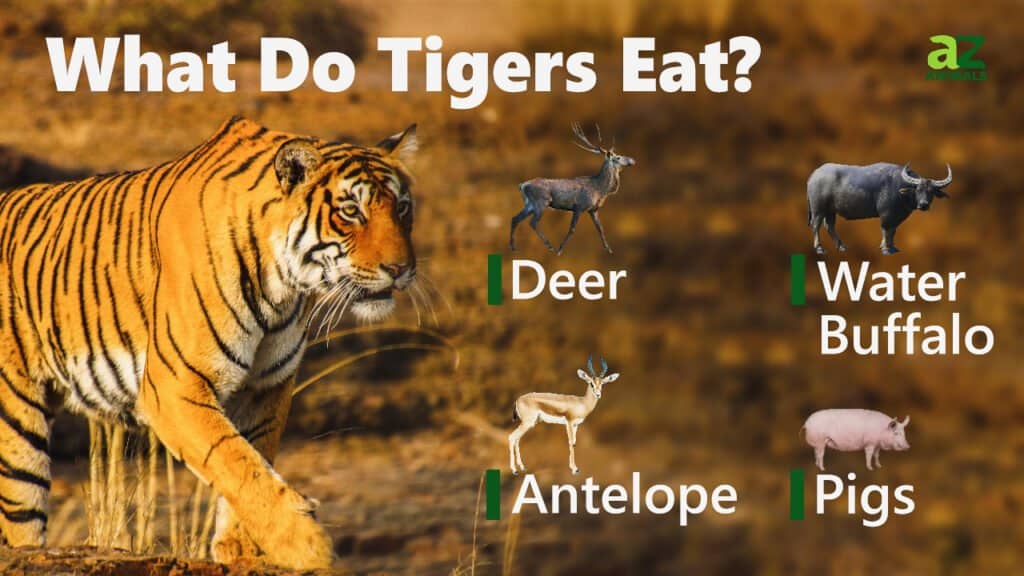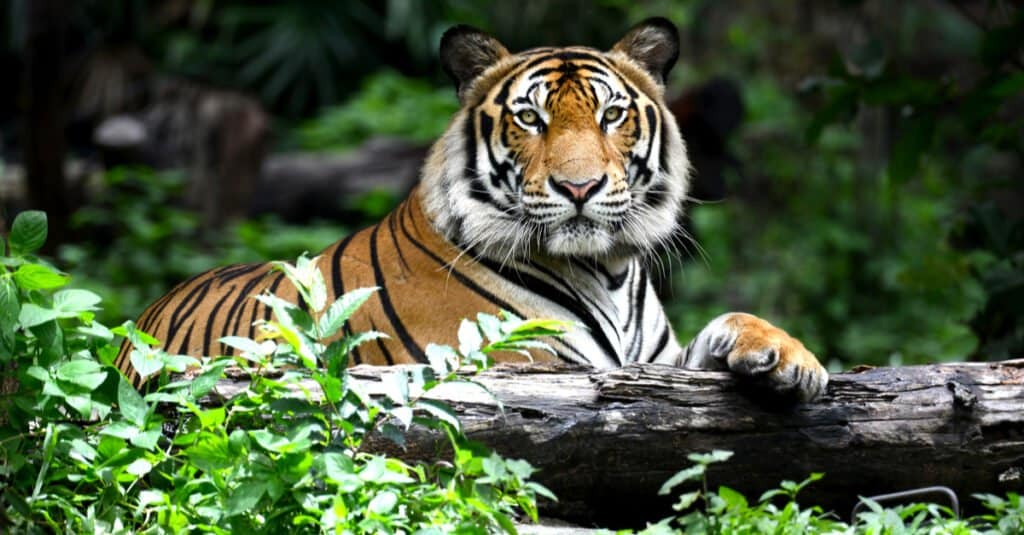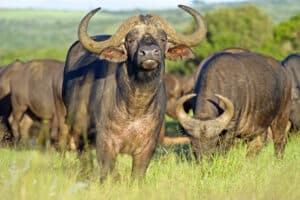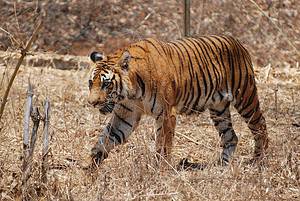Beautiful and fierce, the tiger is the largest of the big cats. Native to Asia, most tiger subspecies are now endangered thanks to unrestrained hunting, poaching, and habitat disruption. As of 2021, there are only between 3062 and 3948 tigers left in the wild.
However, when given the proper care tigers seem to do well in captivity, and many zoos around the world feature tigers. Some tigers are used in circuses, and some people even keep them as pets.
There were a total of 10 subspecies of the tiger 3 of them now being extinct:
- Bengal tiger
- Indian (Bengal) tiger
- Siberian tiger
- South China tiger
- Indochinese tiger
- Malayan tiger
- Sumatran tiger
- Bali tiger (extinct)
- Javan tiger (extinct)
- Caspian tiger (extinct)
A large male can weigh as much as 660 pounds and be 10 feet in length. In contrast, the Sumatran tiger can be eight feet long and weigh a bit over 300 pounds.
Both muscular and sleek, tigers can be easily identified because they have dense fur with a ground color of yellow-orange to brown dramatically and vertically striped with black.
Their bellies are white. The coloration of the tiger is thought to camouflage it as it stalks prey in the jungle where it lives. The cat has a ruff of fur around its neck and jaws, which is more prominent in males. Males are also bigger than females. Tigers are solitary save mothers raising cubs.
White tigers are leucitic Bengal tigers, which means that they lack a pigment that gives Bengal tigers their orange ground color. The ground color of the white tiger’s fur is white, but it still bears the black stripes of a regular Bengal tiger.
White tigers seem to grow faster than normal Bengal tigers and they tend to be bigger. These tigers occur once in every 10,000 births, and their pale color might make camouflage difficult in the jungle. However, some people deliberately breed white tigers for circuses or menageries.
What Foods Do Tigers Eat?

Here are some facts about the diet of tigers. The main animals that tigers eat are moose, horses, buffalos, species of deer, pigs, cows, and goats. The specific diets based on different types of tigers are listed below.
The diet of Bengal tigers is made of:
- Gaur
- Sambar
- Barasingha
- Water buffalo
- Sarow
- Chital
- Takin
- Wild boar
- Hog deer
- Gray langurs
- Porcupines
- Hares
- Peafowl
- Cattle and other livestock
- Humans (if everything else is scarce)
- Elephants (rarely)
The diet of Siberian tigers is made of:
- Manchurian wapiti
- Siberian musk deer
- Siberian roe deer
- Sika deer
- Long-tailed goral
- Wild boar
- Small Asiatic black and brown bears
- Hares
- Rabbits
- Salmon
- Pika
The diet of the critically endangered South China tiger is made of:
- Wild boar
- Hog deer
- Gray langurs
- Hares
- Peafowl
- Porcupines
- Tufted deer
- Sambar
- Muntjac
- Serow
- Livestock
The diet of the critically endangered Indochinese tiger is made of:
- Sambar
- Elephant calves
- Gaur
- Banteng
- Wild boar
- Serow
- Langurs
- Muntjacs
- Porcupines
- Pangolins
The diet of Malayan tigers is made of:
- Sambar deer
- Barking deer
- Borneo bearded pigs
- Serow
- Wild boar
- Elephant and rhinoceros calves
- Livestock
The diet of Sumatran tigers is made of:
- Mouse deer
- Banded pigs
- Malayan tapir
- Porcupines
- Muntjac
- Great argus pheasants
- Pig-tailed macaque
- Sambar deer
What Do Tigers Eat in Captivity vs. in the Wild?

©dangdumrong/Shutterstock.com
People who keep tigers in captivity need to make sure that the animal has a balanced diet among many other things that would keep it healthy. Types of meat fed to tigers around the world include:
Ideally, the meat will be fed with the bones and hide still attached, as the tiger would eat this in the wild. The food might also be rubbed with a vitamin and mineral supplement which the tiger can lick off before it feeds. Facts about feeding in captivity include a tiger is more likely to be obese than too thin, and on average, a male is fed about 15 pounds, and the female is fed 13 pounds of meat a day.
How Do Tigers Hunt Prey?
Tigers are apex carnivores and predators, and they usually do their hunting at night, though daytime hunting has been observed. Like other cats, including pet cats, it’s an ambush predator that leaps out of a hiding place and simply overpowers its prey before it kills it.
A tiger will jump on the back of a large animal, knock it over, and sink its teeth into the back of its neck or its throat in one movement. Tigers can run in short bursts up to 40 miles per hour and leap as much as 33 feet.
A tiger can subdue a large prey simply by clamping its teeth on its windpipe and not letting go until the prey suffocates. Still, tigers usually seek out juvenile, injured, or old members of larger prey. A young, strong, healthy animal the size of an adult gaur, the world’s biggest cow, can be dangerous to tackle.
If the tiger is hunting smaller prey, it will just bite the nape of the animal’s neck, which can sever its spinal cord or major blood vessels, or crush its windpipe. The tiger can also just take a swipe at a smaller animal and crush its skull or break its back. When the prey is killed, the tiger drags it back into the bushes to eat it. Sometimes, if food is abundant, tigers share their kills with other tigers.
Tigers can go for a couple of weeks without food, and then eat as much as 100 pounds of meat at one time.
Do Tigers Have Any Predators?
Besides humans, tigers don’t have predators that actively hunt them. Tiger cubs are sometimes killed by male tigers who aren’t related to them if the mother doesn’t kill the encroaching male first.
The few animals that have been known to kill grown tigers are bears, crocodiles, and packs of an Asiatic wild dog called the dhole.
Tigers coexist with other predators such as leopards, wild dogs, bears, and wolves. Tigers are considered apex predators, which means that they do not have animals that target them. However, sickly or young cubs can be victims to other apex animals.
Do Lions Eat Tigers?
The short answer is no. In their natural habitats, lions and tigers do not typically prey on each other, as their territories and ecosystems differ. Lions typically inhabit savannas and open grasslands in Africa, while tigers are commonly found in the dense forests and grasslands of Asia.
However, in captivity, there are instances where lions and tigers are housed together.
These situations usually occur in zoos or wildlife sanctuaries, where the primary goal is not to replicate their natural interactions but to promote conservation efforts and educate the public about these magnificent big cats.
These captive environments are carefully managed to ensure the safety and well-being of both species while allowing for observation and study by researchers and visitors.
Summary of What Tigers Mainly Eat
| Number | Animal |
|---|---|
| 1 | Moose |
| 2 | Horses |
| 3 | Buffalos |
| 4 | Species of deer |
| 5 | Pigs |
| 6 | Cows |
| 7 | Goat |
The photo featured at the top of this post is © enky03/Shutterstock.com
Thank you for reading! Have some feedback for us? Contact the AZ Animals editorial team.






